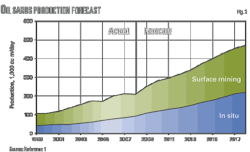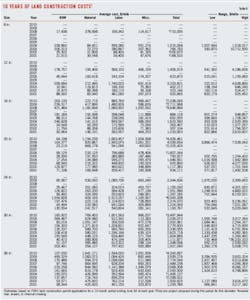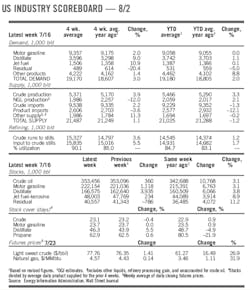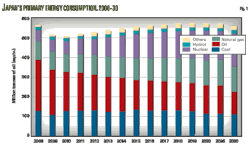GULF OF MEXICO GROWTH FAULT DRILLED, SEEN AS OIL, GAS MIGRATION PATHWAY
Roger N. Anderson, Peter Flemings
Lamont-Doherty Earth Observatory
Palisades, N.Y.
Steven Losh
Cornell University
Ithaca, N.Y.
John Austin, Richard Woodhams
Pennzoil Exploration & Production Co.
Houston
To test the hypothesis that oil and gas can be produced from a fault zone actively involved in secondary migration, we extended the "Pathfinder" well, drilled by Pennzoil Exploration & Production Co. on behalf of partners Exxon, Mobil, and Cockrell Oil Corp., into a growth fault believed to act as a conduit to Eugene Island South Addition Block 330 reservoirs of offshore Louisiana.
The project consisted of three phases: whole coring, extensive logging, and stress and production testing.
We found and sampled oil and gas from silty shales within the fault zone and discovered that these rocks were naturally fractured. Whole coring revealed that the fracturing extended at least 350 ft into the shales of the upthrown block.
The fault zone hydrocarbons are geochemically identical to those sampled from producing reservoirs located within shallower splays of the fault zone system. Hydrocarbons would not flow at economically viable rates during drillstem tests.
The larger the drawdown pressure applied across the perforations, the lower the permeability of the fault zone. However, in this tight spot within the fault zone, the balance between tectonic stresses and pore pressures was found to be such that large volumes of fluid could be transmitted from depth with an increase in pressure of 500 psi or so. The experiments have already provided hints about strategies to make the fault economically producible.
DYNAMIC ER PROJECT
The Global Basins Research Network (GBRN) is an electronic "Internet" organization that was formed to solve two very specific fluid-flow plumbing problems:
- the identification of expulsion mechanisms by which hydrocarbons migrate up fault zones from deep, geopressured strata into shallower reservoirs, and
- the imaging of these active hydrocarbon migration pathways so that wells can be drilled into these "streams" located within fault zones.
As part of a GBRN/Department of Energy/oil industry cost-sharing project, we are experimenting with methodologies by which hydrocarbons can be economically produced from these natural conduits into deeper, as yet unexploited reservoirs.
This article reports on the Field Demonstration Experiments carried out in 1993 in the Pathfinder well, a 700 ft extension of the A-20 ST production well into the fault zone in Eugene Island Block 330 (Fig. 1). The integration of a wide variety of geophysical, geochemical, geological, and reservoir engineering technologies was used to image the hydrocarbon migration processes in Eugene Island 330 and to site the test well in Block 330 itself.
EUGENE ISLAND 330 FIELD
Migration of hydrocarbons from deeper depths, if not active today, has certainly occurred in the recent geologic past in Eugene Island 330 field.1
There are seeps active at the sea floor outcrop of the large growth fault system in Eugene Island 330 today. Oil and gas are being produced in reservoirs as young as 400,000 years old beneath these seeps.
Geochemical monitoring over the last 20 years has recorded temporal changes in the compositions of the oils being produced from the shallow reservoirs that might have resulted from recent injection of wet gases and gasolines into older oilrich accumulations.2 Also, biodegraded oils are being replaced by less biodegraded oils over time in the shallowest reservoirs. Eugene Island 330 field is unusual for its size and oil/gas mix. It is the largest Pleistocene oil field in the world and is surrounded mostly by gas-dominated fields in the south additions of offshore Louisiana.
More than 600 million bbl of oil equivalent has been produced from this field since its discovery in 1971. We chose the Eugene Island 330 field for our fault zone migration study because the field is a classic Gulf of Mexico minibasin.3
A growth-fault system (our Red Fault Zone) forms the northern boundary of the minibasin (Fig. 2). The sediments filling the basin consist of alternating sequences of sands and shales that are likely floored by deepwater turbidites from the ancestral Mississippi River delta.
As the Red Fault Zone accommodated extension toward the deepwater Gulf of Mexico, the sediments in the depobasin were folded into rollover anticlines that are now filled with oil and gas. Extension was caused by the withdrawal to the south of an extensive salt sill present near the surface of the minibasin from six to less than 2.2 million years ago .4
A counter-regional, down-to-the-north fault zone formed the southern boundary of the minibasin with the evacuation of the salt sheet. Hard geopressures separate the shallow shelf sands and shales from the deeper basin floor fan deposits.5 Remnant salt feeder stocks and remobilized salt diapirs ring the minibasin upthrown to the bounding fault system (Fig. 2).
In spite of the removal of the impermeable salt seal, the deeper sediments are still geopressured because the high sedimentation rates and a thick, overlying deep water shale produced permeabilities too low for the compacting pore fluids to escape - a basinwide phenomenon.6
PATHFINDER WELL LOCATION
Migration pathways for hydrocarbons can be imaged within the 3D seismic surveys in Eugene Island 330 field by mapping high amplitude connectivity throughout the volume.1
The "Red" growth fault system is particularly involved in the migration of hydrocarbons, although the conduits are convoluted and more like 3D "streams" than uniform, permeable, 2D fault zone flow paths.
The research strategy of the GBRN is to deepen existing production wells being drilled during the normal operation of Eugene Island 330 field. Pennzoil and partners have drilled approximately 20 new wells since 1991 on Block 330 and have increased production from less than 5,000 b/d in 1990 to approximately 15,000 b/d in 1994.
This strategy, though far more economical than drilling dedicated research wells, places practical limits to the targets available to the GBRN. Consequently, we chose to penetrate the tightest, most shale-prone portion of the fault zone just beneath the deepest known reservoirs trapped against the Red Fault Zone (the OI-4 and 5 sands).
The A-20 ST extension was near but not within a high amplitude seismic conduit, and the well penetrated the zone with highest effective stress concentration along the fault zone. 7
FIELD EXPERIMENTS
The primary economic target of the A-20 ST well was the OI-4 sand located between the "D" and "A" fault splays of the Red Fault Zone (Fig. 3).
The well was spudded Nov. 2, 1993. Pennzoil as operator drilled to 7,035 ft and set 9 5/8 in. casing. It then drilled out and penetrated a section of the OI-4 pay that was 50 ft thicker than the downdip section of this sand, currently on-line in the A-23 well.
The GBRN/DOE extension was begun Nov. 23 at 7,300 ft and ended at 8,075 ft TVD on Dec. 25, 1993. Experiments were carried out in three stages.
Stage I: Whole coring
Pennzoil and partners agreed to log-while-drilling the well extension from the 9 5/8 casing through the OI-4 and OI-5 pay to the point where GBRN would begin to core the fault zone. To our knowledge, no other coring operation has been attempted, knowingly, through an active fault zone in the Gulf of Mexico.
For the first time, we used an experimental antiwhirl bit developed by Baker Hughes Inteq. and Amoco Production Co. We coupled this new coring bit with BHI's hydrolift coring system and a polymer mud containing a 3% synthetic oil-base to prevent balling (developed by M-I Drilling Fluids).
A 60 ft core barrel was chosen over the 30 ft barrel normally used in the gulf. We obtained a total of 343 ft of 4 in. diameter core from an attempted interval thickness of 360 ft, a 95% recovery efficiency. The cutting rates averaged 90 ft/hr and at times exceeded 150 ft/hr in these "gumbo" shales, and the entire coring operation took less than three days.
The core was split into alternating 3 ft chilled and frozen sections and is available for further study from the GBRN Core Repository at Pennsylvania State University.
The cored interval was 7,330-7,680 ft, and overall the rock consisted primarily of silty shale with minor sand beds. The Formation MicroImager (FMI) log indicates the cored interval begins just below the deformation zone mapped as the Red Fault and extends across a second, minor fault not imaged by the seismic surveys. The shales away from the fault zones all dip 20-30 to the north-northwest.
There were three primary structural domains.
An upper faulted zone extends from 7,330-7,490 ft and contains slickensided faults at moderate to high angles. Many are filled with drilling mud, indicating fracture permeability.
A middle zone from 7,490-7,560 ft is relatively unfaulted. The rock consists of silty shale, shaly silt, and thin, yellow fluorescing sand beds, the thickest measuring 9 in. Much of this interval corresponds with a slight increase in resistivity and may be low resistivity pay.
Finally, a lower fault zone was encountered from 7,560-7,680 ft. It consists of silty shales with gouge zones that intersect the well at low angles. Slickensided faults reappear, but dip at a variety of angles. Much more fluorescence is apparent in both low- and high-angled structures. Oil is present in some fractures, as can be seen in the ultraviolet image shown in Fig. 4. This fracture also contains slickensides.
The planning and execution of the coring stage of the project was a collaborative effort involving the GBRN scientists, and many supporting oil and service companies, and the success was directly attributable to this collaboration.
For example:
- An Exxon coring specialist, Mike Wooten, oversaw the on-site coring effort.
- Texaco, Chevron, and Conoco provided mud composition advice.
- Core Labs processed and archived the core.
- A Chevron scientist collected gases.
- Shell and Exxon provided CAT-scanning.
- GERG/Texas A&M and Woods Hole ran the organic geochemistry.
- Cornell provided structural and fracture mapping.
- Penn State handled acoustic correlation with seismic.
- Schlumberger did the major element chemistry.
- The University of Michigan and Michigan Tech ran the pore water chemistry.
- the University of Rochester age dated the pore fluids.
- Pennzoil handled the paleontology and biostratigraphy.
- The U.S. Geological Survey took vitrinite reflectance measurements.
- Mobil, Exxon, and the University of Virginia conducted gas source and maturity analyses.
STAGE II: EXTENSIVE LOGGING
The GBRN then logged from TD at 8,010 ft to casing at 7,046 ft with a full suite of acoustic, nuclear, and electrical "imaging" logs from Schlumberger to obtain as complete a picture of the fault zone as possible. The electrical logs obtained were array induction and formation micro-imager (FMI) for resistivity imaging at mm-scale resolution of the borehole wall.
Possible pay was indicated within the fault zone by the induction log, and the FMI showed that a considerable part of the OI-5 pay was, in fact, significantly disrupted by movement downthrown to the fault zone.
As indicated by dip "tadpoles" (Fig. 3), the OI-4 sand has normal, 10-20 regional dips to the north. Below this, the OI-5 dips steeply to the west, then steeply to the east, before the fault zone top is encountered at 7,270 ft TVD. The fault is defined by 40 ft of down to the southwest-dipping fractures.
Below 7,310 ft, footwall deformation is seen to 7,350 ft, where 20-30 dips to the north return. No further down-to-the-southwest fractures are imaged by the FMI until the small fault zone seen in the cores in encountered at 7,5607,680 ft, although the core revealed that many such small fractures exist throughout the footwall section.
The FMI revealed that the lower half of the OI-5 target was within the fault zone itself, and consequently, we had begun our coring program about 10 ft below the deepest down-to-the-southwest fracture within the fault zone imaged by the FMI.
From the bottom of the fault zone upward (Fig. 5), the FMI revealed a zone of interbedded shales and silts with gentle dip, but cut by southwest dipping fractures with increasingly more throw until a distinct surface dipping 55 to the southwest was mapped at 7,280 ft.
Above this discontinuity, highly deformed, silty shale is found, cut by an antithetic fault. Three large vertical fractures were mapped above this deformation zone, and each was found to have high electrical resistivity, possibly indicative of hydrocarbon charge. These natural fractures strike in the orientation of the fault zone and may connect the fault zone hydraulically with the overlying 014 and 5 pay in the downthrown block.
Certainly the compositions of the oils recovered from the fault zone are identical to the 01-4 oils currently being produced in the A-23 well (see below).
The dipole sonic log then recorded compressional, shear, and Stoneley waveforms across the fault zone (Fig. 6). While compressional velocities decreased by 10% from the downthrown to the upthrown blocks across the fault zone, the shear velocity decreased by more than 20%. The specially designed dipole shear source excited a shear wave only slightly faster than the Stoneley wave. The fracturing is thought to be the cause of the low shear velocities, and extensive acoustic measurements are planned at in situ conditions for the core samples.
A new geochemical logging tool was then lowered across the fault zone. Using a controlled source of neutrons, this logging tool measures elemental composition of the rock by neutron activation - in real time. Distribution of the elemental abundances into a mineralogy model by Schlumberger verifies the rock above and below the fault zone is shale - quartz contents less than 20% and clay contents greater than 40% in a total volume with 25% porosity (Fig. 6).
The fault zone itself appears to be somewhat more silty with quartz contents of slightly more than 25%. This logging tool also records neutron porosity and gamma ray density.
The modular dynamics formation tester (MDT) was next to be run. The plan was to use this tool to obtain at least 12 pressures throughout the well extension, but because of the hole conditions, the MDT was stuck obtaining the first pressure measurement. Pennzoil then acquired 75 sidewall cores from 7,157-7,661 ft in three coring runs in the hole, including valuable samples from within the major deformation zone of the fault zone.
STAGE III: STRESS AND PRODUCTION TESTING
On Dec. 2, 1993, we ran a 7 5/8 in. liner into the well extension. As a result of a bad cement job, we were required to squeeze cement into the intervals directly above and below our test zone to insure isolation.
Stress tests were performed below the fault at 7,380-84 ft, within the fault at 7,270-7,310 ft, and above the fault at 7,240-44 ft to obtain pore pressures and compressive stress magnitude variations across the fault zone.
The difference between the minimum horizontal stress (S3) and the fluid pressure (P) controls the hydraulic conductivity of the fault zone. As the fluid pressure converges upon the minimum horizontal stress, significant fracture permeability is opened.
Our stress and pore pressure measurements allowed us to measure these in situ conditions above, below, and within the fault zone. We measured pore pressures of 0.8 S1 (0.8 psi/ft.) above and 0.95 S1 (0.9 psi/ft) below the fault zone. S1 is the maximum stress, in this case the vertical overburden stress. Direct measurements of the stress field show that fluid pressures of an additional 500 psi (S3-P = 500 psi), would be required to reopen fractures and allow significant fluid flow within this segment of the fault zone.
It is interesting to note that column heights in the reservoirs just above this depth result in buoyant pressures of approximately 500 psi. Thus, it is possible that at this level the hydrocarbon columns are "topped off" in a state of dynamic equilibrium. This in turn implies that any significant new charge of hydrocarbons arriving at this level of the fault system would be able to naturally fracture its way upward to lower pressure reservoirs.
We believe the vertical fractures are reflecting this migration pathway mechanism of transport from the fault zone to the reservoirs (Figs. 5, 7). A fundamental question we continue to address is whether this process of ongoing vertical migration is presently occurring.
We then perforated, fracpacked, and flow tested a 40 ft interval within the fault zone (Fig. 8). On Dec. 14, 1993, the tubing-conveyed perforating gun was fired at 7,270-7,310 ft. Since only a trickle of flowback was seen at the surface, low permeability of the formation was assumed.
We then hydraulically fractured the perforated interval using Dowell's new telemetry capability in which the test was monitored in real-time in the Dowell offices in Lafayette, La. The following procedures were used:
- an acid job was performed to clean the perforations and formation near the wellbore,
- a mini-fracture was created using stepped-rate injection into the formation, and several constant rate stress tests followed (essential for the final design of the frac-pack), then
- the well was shut in to retrieve the downhole data recorded on the Schlumberger DataLink system. The fracture design was then finalized, and the hydraulic fracture completed. However, the fracture pumps stalled out at the beginning of the final injection stage, preventing the downhole completion of the frac job. Although a tip screen-out was thought to be observed at the surface, later retrieval of the downhole DataLink recorders showed that the increased surface pressure was from frictional loss and not from fracture completion in the formation. Although the highest permeability recorded after the frac job was only 120 md, fluids immediately began to flow to the surface at a rate of 50 b/d at 400 psi against a 36.3 lb/gal zinc bromide completion fluid.
Then the drillstem test assembly was tripped into the hole to flow test the fault zone interval. The flow test began with a rate of 192 b/d and within 2 hr had dropped to less than 50 b/d. Pennzoil then called out a coiled tubing unit to jet the well in with nitrogen. Once this procedure began, the flow rate increased to 200 b/d but would not sustain itself. We did, however, sample 16 gal of oil for laboratory analysis - hydrocarbons that unquestionably came from within the fault zone.
As the jetting drew higher and higher differential pressures against the formation, the formation flowed less and less until flow completely stopped at more than 5,000 psi of drawdown differential. In other words, the more underbalanced we were, the less the formation flowed (Fig. 8).
The fracture permeability in the fault zone is pressure-dependent, and as we drew down the pressure in the wellbore, the fracture network supplying the permeability within the fault zone became tighter and tighter.
This conclusion is verified by an analysis of hydrocarbon column heights trapped against the Red Fault Zone. 7 The authors of that analysis found that the fracture closure stress within the fault zone requires 500-600 psi of additional pressure to open the fault zone to hydrocarbon flow (Fig. 7).
This observation was verified on the rig when we shut down the jetting, re-equilibrated our wellbore, then pumped fluid into the formation through the perforations (to verify that they were not plugged off). The fault zone took fluid easily at about 500 psi over ambient fluid pressures. Pennzoil plugged the fault zone interval on Dec. 25, 1993, and will complete in its economic target, the OI-4 formation in 1994.
LESSONS LEARNED
To date, the GBRN/DOE/industry project has established that hydrocarbons are present within even the tightest, most restricted portion of the fault zone and has sampled them.
We measured the state-of-stress and pore pressure variation surrounding and within the fault zone and have found the fault would open to an additional 500 psi pressure increase. We have recovered 340 ft of whole core and have found the shales in and near the fault zone to be heavily fractured.
We have made a large array of physical and chemical measurements in situ in the fault zone and have eliminated the possibility that hydrocarbons recovered may have come from the footwall. For example, both salinity gradients and thermogenic-to-biogenic gas transitions argue against switch-backing across sand bodies in the Pathfinder area. Also, there are no sands to speak of either seismically imaged or cored in the well.
What happens deep in the geopressured turbidites of the subsalt play, we now think, is that formation pressures increase until fracture-reopening stresses are periodically overcome in the fault zones that connect into the chambers. At that time, large volumes of hydrocarbons are released rapidly in transient bursts towards the surface, and then the faults close back up.
Put another way, with added pressure, oil is expelled up the fault zones, but then the very act of releasing the fluids drops the pressure and the faults become tight again. Over and over, the cycle repeats.
The Field Demonstration Tests have shown that oil and gas are recoverable from the fault zone in Eugene Island 330 and would flow under pressure, so our focus now shifts to finding approaches to make the fault economically producible. The experiments have already provided insights into potential strategies for future production:
- Locate wells into higher permeability sand-smear within the fault zones (i.e. target higher seismic amplitude zones).
- Change the angle of penetration from perpendicular to parallel to the fault zone (i.e. drill along the fault zone to expose more surface area).
Because production is controlled by the permeability multiplied by thickness, these strategies would increase permeability by drilling higher seismic amplitudes and increase thickness by drilling within the plane of the fault rather than perpendicular to it.
It is likely that the GBRN/DOE methodology of integrating geophysical and geochemical dynamics with the more traditional stratigraphic and structural observations will lead to better methods of exploiting the large volumes of deep, geopressured reserves that remain to be produced not only in the Gulf of Mexico, but in other sedimentary basins where hydrocarbons are currently migrating out of deep geopressured chambers, such as in Nigeria, the North Sea, Indonesia, and the Caspian Sea.
ACKNOWLEDGMENTS
Reprints of this article and three previous articles, VHS videotapes, and CD-Rom data from the GBRN field demonstration experiment are available from Dave Roach, Lamont-Doherty Earth Observatory of Columbia University, Rt. 9-W, Palisades, N.Y. 10964-8000.
The Field Demonstration Team of the GBRN consisted of Laurel Alexander, Cornell; Dan Atkinson, Texas A&M/GERG; Lana Billeaud, Lamont; Beth Bishop, Penn State; Anil Deshpande, Penn State; Lorraine Eglinton, Woods Hole Oceanographic Institution; Gilles Guerin, Lamont; Susan Haggerty, Exxon; Bruce Hart, Penn State; Wei He, Lamont; Paval Peska, Stanford; Jim Richards, Michigan; Dave Roach, Lamont; Erich Scholz, Martin Schoell, Chevron; Chris Shaw, Exxon; Jeff Wolfe, Penn State; Mike Wooten, Exxon; and Mark Zoback, Stanford. Work was supported by the Department of Energy, Class 1 Oils, Advanced Recovery Program, under contract DE-FC22-93BC14961.
Companies contributing cost-sharing were Advanced Visual Systems, Arco, Chevron, Cockrell, Conoco, Elf Aquitaine, Engineering Animation, Exxon, Hypermedia, Landmark Graphics, Mobil, Pennzoil, Shell, and Texaco. We wish to thank Pennzoil, operator of Eugene Island Block 330, for its support of this project and in particular Torphy Avan, Dick Ellis, Scott Jointner, David Lammlein, Jack Leedy, Brad Moody, Mike Osborne, David Pettis, Roger Rogier, Sid Sadicki, Deet Schumacher, Bill Van Wie, and Nick Mallory.
REFERENCES
- Anderson, R.N., Recovering dynamic Gulf of Mexico reserves and the U.S. energy future, OGJ, Apr. 26, 1993, p. 85.
- Whelan, J.K., Kennicutt, M.C., Brooks, J.M., Schumacher, D., and Eglinton, L.B., Organic geochemical indicators of dynamic fluid flow processes in petroleum basins, in proceedings, European Assoc. Org. Geochemists, in press, 1994.
Alexander, L., and Flemings, P.B., Hydrostratigraphy of the Eugene Island 330 mini-basin, AAPG, submitted, 1994.
Rowan, M., and Weimer, P., Sequence stratigraphy, salt movement, and the structural evolution of the South Addition, Eugene Island, offshore Louisiana, in preparation, 1994.
He, W., and Anderson, R.N., Predicting top-of-geopressure using seismic attributes in the Pleistocene offshore Louisiana Gulf of Mexico, J. Geophys. Res., submitted, 1994.
Mello, U.T., Karner, C.D., and Anderson, R.N., A physical explanation for the positioning of the depth to the top of overpressure in shale-dominated sequences in the Gulf Coast basin, U.S., J. Geophys. Res., Vol. 99, 1994, pp. 2,775-89.
Flemings, P.B., Zoback, M.D., and Anderson, R.N., State-of-stress in and around a Gulf of Mexico growth fault, Eugene Island 330, in initial reports of the Pathfinder well, EI 330, GBRN press, 1994.
Hart, B.S., Deshpande, A., and Flemings, P.B., Formation pressures in the Pathfinder well, in initial reports of the Pathfinder Well, EI 330, GBRN press, in press, 1994.
Copyright 1994 Oil & Gas Journal. All Rights Reserved.





